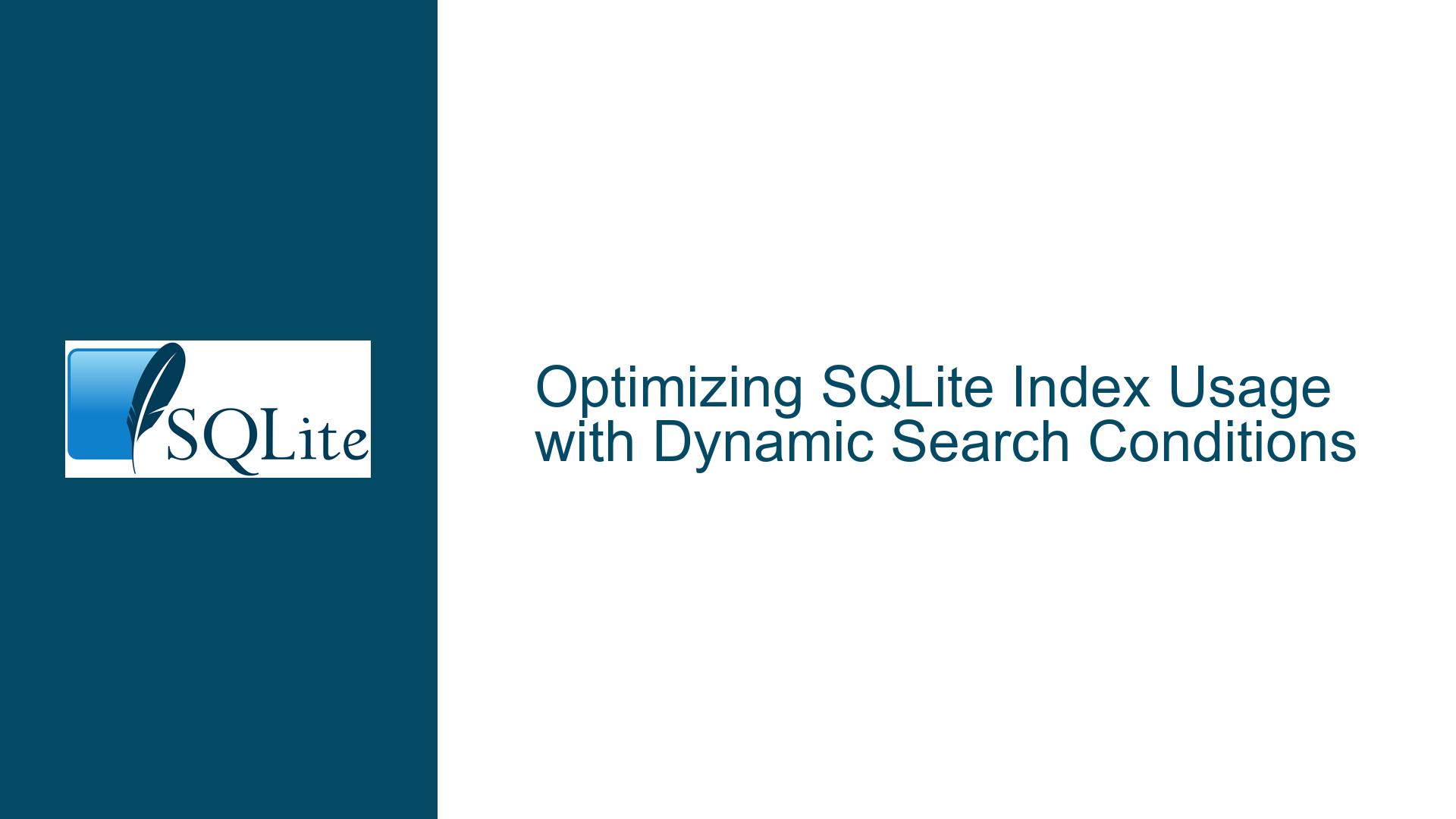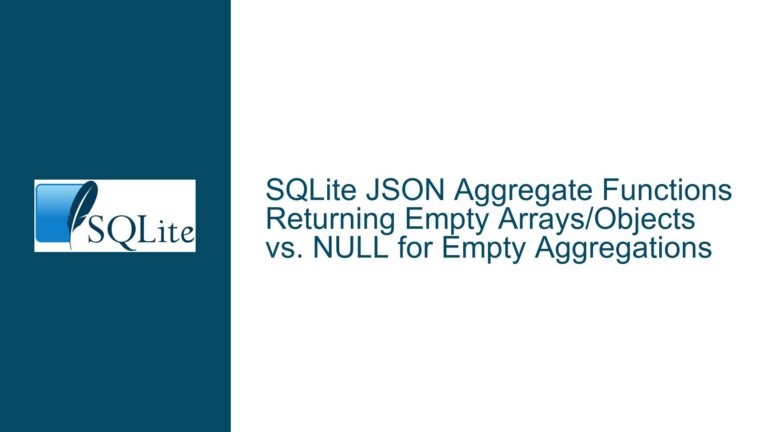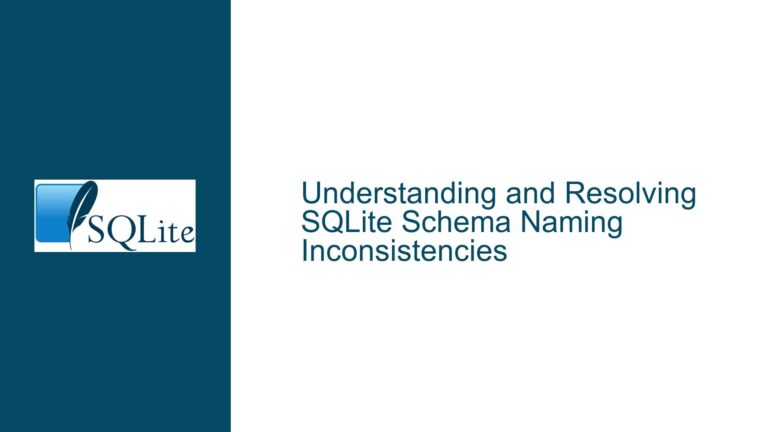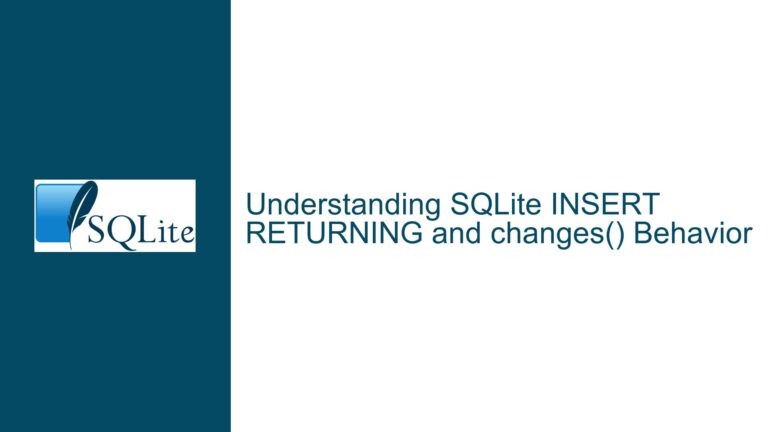Optimizing SQLite Index Usage with Dynamic Search Conditions
Understanding Index Utilization in SQLite for Conditional Queries
The challenge of efficiently utilizing indexes in SQLite when constructing dynamic search conditions involving multiple AND/OR operations or CASE tests is a common pain point for developers working with large datasets. This guide dissects the root causes of index avoidance in such scenarios and provides actionable solutions to ensure optimal query performance.
Core Problem: Indexes Ignored in Multi-Condition Queries
Scenario
A table Table1 is indexed on individual columns (field1, field2, field3) and a composite index (field1,field2,field3). Queries dynamically filter results based on user-provided parameters (e.g., $field1, $field2, $field3), which may be empty. The goal is to construct a single query that adapts to filled parameters while leveraging indexes.
Observed Behavior
Queries using CASE, COALESCE, or OR logic to handle empty parameters result in full table scans (SCAN TABLE table1) instead of index usage. For example:
SELECT * FROM Table1
WHERE
CASE WHEN COALESCE($field1, '') <> '' THEN field1 = $field1 END AND
CASE WHEN COALESCE($field2, '') <> '' THEN field2 = $field2 END;
Despite indexes existing, SQLite’s query planner avoids them due to structural inefficiencies in the query logic.
Why Indexes Are Not Used: Query Planner Limitations
1. Non-Prefix Index Constraints
SQLite requires equality conditions on the leftmost columns of a composite index. For example:
- The composite index
(field1,field2,field3)can only be used iffield1is constrained. - A query filtering on
field2andfield3withoutfield1cannot use this index.
Example Failure
A query with WHERE field2 = $field2 AND field3 = $field3 will not use the composite index testindexf123 because field1 is not constrained.
2. OR Conditions and Constant Folding
SQLite’s query planner does not aggressively simplify OR conditions or evaluate constant expressions before selecting an execution plan. For instance:
WHERE ('' = $field1 OR field1 = $field1)
If $field1 is empty, the condition simplifies to TRUE, but SQLite does not eliminate the OR clause at compile time, leading to a scan.
3. CASE Statements and Dynamic Logic
CASE expressions introduce branches that obscure the query’s intent to the query planner. The planner cannot statically determine which branches will execute, making index selection unreliable.
4. Covering Index Misconfiguration
A "covering index" includes all columns required by a query, eliminating table lookups. However, composite indexes must be ordered correctly. For example, an index on (field2,field3,field1) covers WHERE field2 = $field2 AND field3 = $field3 but not WHERE field1 = $field1 unless field1 is part of the index prefix.
Solutions for Index-Aware Dynamic Queries
Step 1: Dynamic Query Construction
Build the SQL query programmatically based on provided parameters. This avoids CASE/OR complexity and ensures conditions align with index prefixes.
Example in Bash
#!/bin/bash
conditions=()
params=()
add_condition() {
if [[ -n "$2" ]]; then
conditions+=("$1 = ?")
params+=("$2")
fi
}
add_condition "field1" "$field1"
add_condition "field2" "$field2"
add_condition "field3" "$field3"
where_clause=""
if [[ ${#conditions[@]} -gt 0 ]]; then
where_clause="WHERE $(IFS=" AND "; echo "${conditions[*]}")"
fi
query="SELECT * FROM Table1 $where_clause;"
sqlite3 tst.db "$query" "${params[@]}"
Advantages
- Produces queries like
SELECT * FROM Table1 WHERE field1 = ? AND field2 = ?, which align with index prefixes. - Avoids unnecessary
OR/CASElogic.
Step 2: Strategic Index Design
Create indexes that match common query patterns. Prioritize:
- Single-Column Indexes for frequently filtered individual fields.
- Composite Indexes ordered by selectivity (most selective fields first).
- Covering Indexes for queries returning specific columns.
Example
For a query filtering on field2 and field3:
CREATE INDEX idx_field2_field3 ON Table1(field2, field3);
Step 3: Forcing Index Usage
Use INDEXED BY hints sparingly to override the query planner. This is a last resort and requires thorough testing.
SELECT * FROM Table1 INDEXED BY testindexf123
WHERE field1 = $field1;
Step 4: Parameter Binding with NULL
Use NULL for empty parameters and rewrite conditions to IS NULL. SQLite treats unbound parameters as NULL by default.
Rewritten Query
SELECT * FROM Table1
WHERE
(field1 IS NULL OR field1 = $field1) AND
(field2 IS NULL OR field2 = $field2) AND
(field3 IS NULL OR field3 = $field3);
Binding Parameters
- Bind
NULLwhen a field is empty (e.g., usingsqlite3_bind_null()in C or parameter substitution in higher-level languages).
Step 5: Leveraging Multi-Index Optimization
Add a dummy OR condition to trigger SQLite’s multi-index optimization:
SELECT * FROM Table1
WHERE
(field1 = $field1 OR field2 = $field2 OR field3 = $field3) AND
($field1 IS NULL OR field1 = $field1) AND
($field2 IS NULL OR field2 = $field2) AND
($field3 IS NULL OR field3 = $field3);
This forces the planner to consider multiple indexes, though it may not always work as intended.
Advanced Techniques and Workarounds
1. Partial Indexes
Create indexes filtered on non-empty values:
CREATE INDEX idx_field1_nonempty ON Table1(field1) WHERE field1 <> '';
2. Materialized Views
Precompute common query results using triggers or temporary tables.
3. Query Plan Analysis
Use EXPLAIN QUERY PLAN to verify index usage:
EXPLAIN QUERY PLAN
SELECT * FROM Table1 WHERE field1 = 'value';
4. Statistical Metadata
Ensure SQLite has up-to-date statistics for the query planner. Run:
ANALYZE;
5. Recompiling with SQLITE_ENABLE_STAT4
Enable advanced statistics for better index selection (requires compiling SQLite from source).
Conclusion
Efficient index usage in SQLite for dynamic queries hinges on aligning query structure with index design and avoiding logic that obscures the planner’s ability to infer constraints. By constructing queries programmatically, optimizing indexes, and leveraging parameter binding, developers can achieve sub-millisecond response times even on terabyte-scale datasets. Always validate changes with EXPLAIN QUERY PLAN and prioritize simplicity over clever but unreadable SQL constructs.






